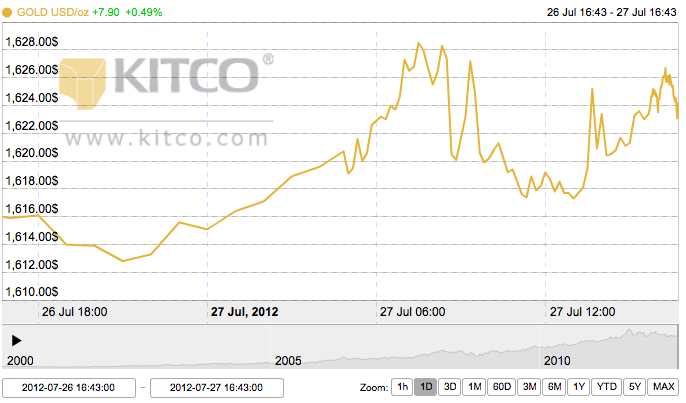Monday Open: $1,578.90
Weekly High: $1,626.70
Weekly Low: $,1569.10
Friday Close: $1,624.20
After weeks of a hesitant gold market driven by uncertainties surrounding the European debt crisis and continued lack of U.S. monetary easing, gold finally broke confidently above the $1,600 barrier this week when a series of reports started signaling a weaker euro ahead. Gold gained around $60 from the slow beginning of the week to a somewhat anticipatory closing, moving from the greatest inverse correlation to the dollar since January to the highest price of gold in more than a month.
Gold investors started out the week skeptical as the dollar reached a two-year high and gold stood at a -0.718 correlation with the paper currency, the strongest since the beginning of the year. Since gold trades inversely to the dollar, the yellow metal weakened as the greenback gained strength.
Worries over the Eurozone debt crisis continued to plague gold at the beginning of the week, but took a few surprising turns as the days rolled on. Tuesday started a very slight uptrend when Greece announced the country probably would not be able to pay its debts, indicating to investors there could be room for economic restructuring.
Then, Spain and France announced on Wednesday that the Eurozone would be adopting a common strategy to stabilize the euro, including enacting a supervisory mechanism on all euro area banks. This could mean that the European Central Bank could get significant and cheap funding, which could subsequently devalue the euro, thus elevating gold in a similar inverse fashion as the gold-dollar relationship. Sure enough, Wednesday saw gold reaching a two and a half week high after this news broke.
But it doesn’t end there.
Thursday continued the path of European restructuring and gold was bumped even higher after ECB president Mario Draghi proclaimed that he was ready and willing to take any steps necessary to float the euro. Specifically, “The ECB is ready to do whatever it takes to preserve the euro,” he said. Speculators can decode that as meaning that the bank will be inclined to print more paper money, which would inevitably reduce the strength of the currency and encourage investors to flock back to gold as an established safe haven.
Peter Schiff of EuroPacific Capital is one industry spokesperson who sees this as a major breakthrough for gold. The metal has been stuck in a limbo for a while, and Asian and Indian investors are still generally sitting on the sidelines as their economies stumble through some bumps this year. But while investors have been waiting anxiously for a signal from Federal Reserve chairman Ben Bernake that the U.S. would start printing more money, instead they got that confirmation from the European Central Bank regarding the euro, and it’s no small potatoes.
Schiff said on Thursday, “I’m surprised that gold is not rallying even more considering what’s happening. Gold has now broken out of a channel. There was a very nice trendline and we just broke out of that today. Now that we have broken out of that channel, there is a lot of room to the upside.”
It should be an interesting time ahead for gold.

Leave a Reply